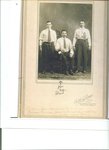 Narrowsburg
NarrowsburgLight Rain Fog/Mist, 43°
Wind: 8.1 mph
 Narrowsburg
NarrowsburgThe trunk from Russia currently sits in my bedroom here in French Woods, NY. In the off season I store our winter coats and snow clothes in it. Sometimes I stash Christmas presents in the old, heavy …
Stay informed about your community and support local independent journalism.
Subscribe to The River Reporter today. click here
This item is available in full to subscribers.
Please log in to continue |


The trunk from Russia currently sits in my bedroom here in French Woods, NY. In the off season I store our winter coats and snow clothes in it. Sometimes I stash Christmas presents in the old, heavy trunk. It rests, inconspicuously, in the corner under the east window.
But once a year, the old trunk comes alive again to its past purpose. Each fall my husband, John, loads it into his car to take to Sullivan West High School where he is a teacher. He uses the trunk as a prop in his history classes. The trunk takes center stage in a unit he does on immigration.
The trunk originally belonged to John’s maternal great-grandfather, Stephen Kushner, who made his way to America from Poland in 1909. Kushner was born in Kulno, Poland, then part of the Russian empire, in 1882. His reason for immigrating seems to have been twofold. He wanted to escape the turmoil caused by the Russian Revolution of 1905, and he wanted to avoid continued conscription in the Russian army after fighting in the bloody Russo-Japanese War (1904-05).
Kushner’s long journey to the United States began in Krakow, Poland when he bought his ticket for passage on the German ship the Kaiser Wilhelm. He then traveled by train to Bremen, Germany where he boarded the ship as a third-class passenger bound for New York. Finally he settled in Philadelphia, PA, and sent for his wife, whom he had left in Poland.
Each year, John and I laboriously haul great-grandfather’s old trunk down our twisting stair case and out to the Toyota for the trip to Sullivan West. Each year, I ask the same question: “Are you sure it will fit in the car?” Never mind that the trunk made the long journey from Poland so many years ago. “I just don’t feel like lugging it to school,” says John. “Wow. Laziness. But then I think about how far my family had to travel.”
This year, John asked his eighth-grade students to imagine what they would bring with them in a trunk that size if they were taking a long journey as immigrants. The list of items ranged from the essential such as “water” and “nonperishable food,” to the practical, such as “money,” “charger,” “undergarments” and “birth certificate” to the nostalgic such as “my mother’s recipes” and “my music.” Other choices were very specific such as “Xbox One” and “PlayStation 4.” He also asked his students to imagine what they would leave behind.
John’s grandmother, Anna, was born in Philadelphia. But her older brother was left behind when his parents came to this country. For years this was a family secret. Out of fear, John’s grandmother hid the letters that her brother sent years later with Soviet postage during the Cold War years. She was afraid, she said. “They will put us in camps,” she told her family. Eventually, all contact was lost.
It is stories like this and John’s great-grandfather’s trunk that serve as a reminder of the humanity of all immigrants. In a country whose citizens seem so infatuated with discovering their roots and genealogy through such forums as Ancestry.com it is disconcerting to see the current divisions surrounding immigration reform. Humanizing the issue of immigration is, for today’s students, the only way we will ever attempt to solve these complex problems.
Comments
No comments on this item Please log in to comment by clicking here